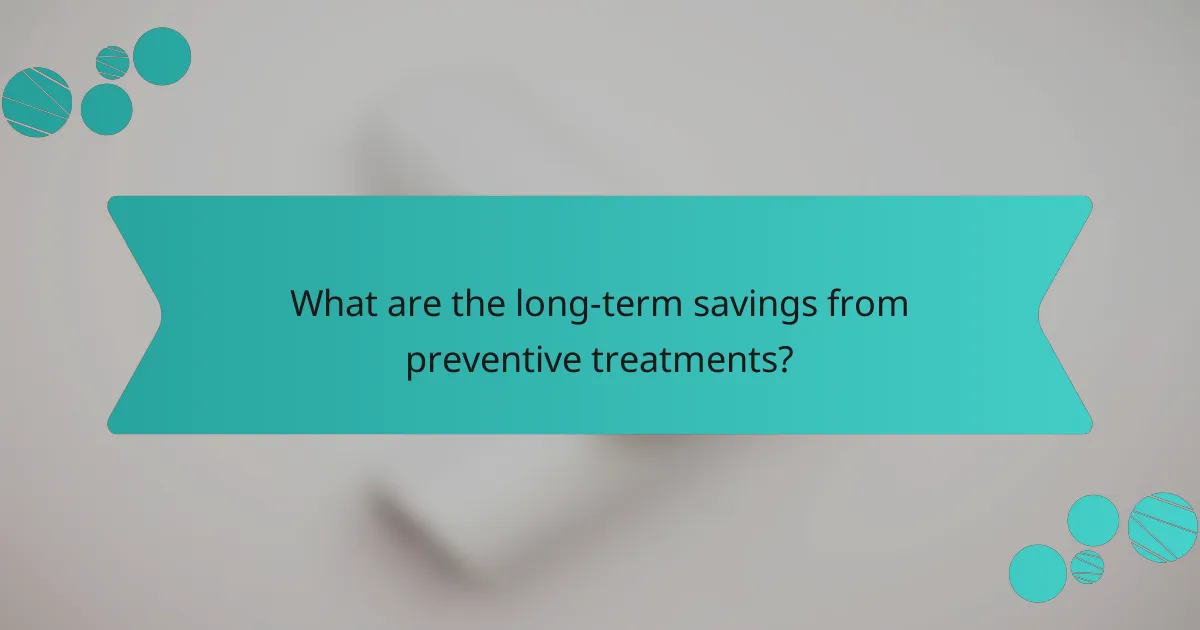Preventive treatments are essential for reducing disease risk and lowering long-term healthcare costs, offering significant benefits to both individuals and public health systems. Insurance coverage for these services enhances accessibility and affordability, ultimately leading to improved health outcomes. By prioritizing preventive care, we can achieve substantial long-term savings and reduce the need for costly medical interventions in the future.

What are the cost-effective preventive treatments in Canada?
Cost-effective preventive treatments in Canada include various health measures that reduce the risk of disease and lower long-term healthcare costs. These treatments not only improve individual health outcomes but also contribute to overall public health savings.
Vaccinations
Vaccinations are a cornerstone of preventive healthcare, protecting individuals from infectious diseases. In Canada, vaccines are often covered by provincial health plans, making them accessible and cost-effective.
For instance, childhood vaccinations against diseases like measles and mumps are provided at no cost, significantly reducing the incidence of these illnesses and their associated healthcare costs. Adults should also consider vaccines like the flu shot and shingles vaccine, which can prevent serious health complications.
Regular health screenings
Regular health screenings help detect potential health issues early, often before symptoms arise. In Canada, many provinces offer free screenings for conditions such as breast, cervical, and colorectal cancer.
These screenings can lead to early intervention, which is typically less expensive than treating advanced diseases. For example, a mammogram can identify breast cancer at a stage where treatment is more effective and less costly.
Dental check-ups
Routine dental check-ups are essential for maintaining oral health and preventing costly dental procedures in the future. In Canada, many insurance plans cover regular dental visits, making them a financially sound choice.
Regular visits can help identify issues like cavities or gum disease early, allowing for less invasive and less expensive treatments. It’s recommended to schedule dental check-ups at least twice a year to ensure optimal oral health.
Chronic disease management programs
Chronic disease management programs are designed to help individuals manage conditions such as diabetes, hypertension, and asthma effectively. These programs often include regular monitoring, education, and support, which can reduce the risk of complications.
In Canada, many healthcare providers offer these programs, which can lead to significant long-term savings by preventing hospitalizations and emergency care. Engaging in such programs can empower patients to take control of their health and reduce overall healthcare costs.
Nutrition counseling
Nutrition counseling provides personalized dietary advice to help individuals make healthier food choices. This service can be particularly beneficial for those at risk of obesity, diabetes, or heart disease.
In Canada, some health insurance plans cover nutrition counseling, making it an accessible option for many. By working with a registered dietitian, individuals can learn to create balanced meal plans that promote long-term health and potentially lower medical expenses related to diet-related conditions.

How do insurance benefits support preventive treatments?
Insurance benefits play a crucial role in making preventive treatments accessible and affordable. By covering various preventive services, insurers help reduce overall healthcare costs and improve long-term health outcomes.
Coverage for vaccinations
Most health insurance plans cover a range of vaccinations without requiring a copayment or deductible. This includes vaccines for diseases such as influenza, measles, and HPV, which are essential for preventing serious health issues.
For example, under the Affordable Care Act in the U.S., all recommended vaccines for adults and children are covered, making it easier for individuals to stay up to date on their immunizations.
Preventive care services included
Insurance benefits typically include a variety of preventive care services, such as annual check-ups, screenings, and counseling. These services are designed to detect health issues early and promote healthy behaviors.
Common services covered may include blood pressure checks, cholesterol screenings, and cancer screenings like mammograms and colonoscopies, often with no out-of-pocket costs.
Cost-sharing arrangements
Cost-sharing arrangements, such as copayments and deductibles, can vary significantly among insurance plans. Many plans waive these costs for preventive services, encouraging individuals to seek necessary care without financial barriers.
It’s advisable to review your specific plan details to understand what preventive services are fully covered and if any cost-sharing applies.
Health spending accounts
Health spending accounts, such as Health Savings Accounts (HSAs) and Flexible Spending Accounts (FSAs), allow individuals to set aside pre-tax dollars for medical expenses, including preventive treatments. These accounts can help manage out-of-pocket costs effectively.
Using these accounts for preventive care can lead to significant savings, as funds can be used for services that may not be fully covered by insurance or for additional treatments that promote health and wellness.

What are the long-term savings from preventive treatments?
Long-term savings from preventive treatments can be significant, as they reduce the need for more expensive medical interventions later. By investing in preventive care, individuals and healthcare systems can lower overall costs while improving health outcomes.
Reduced healthcare costs
Preventive treatments often lead to lower healthcare costs by minimizing the incidence of chronic diseases and serious health conditions. For instance, regular screenings and vaccinations can prevent illnesses that would otherwise require costly treatments or hospitalizations.
Studies suggest that for every dollar spent on preventive care, there can be a return on investment of several dollars in reduced treatment costs. This is particularly relevant in countries with high healthcare expenses, such as the United States, where chronic diseases account for a significant portion of healthcare spending.
Lower medication expenses
Preventive treatments can significantly lower medication expenses by addressing health issues before they escalate. For example, managing conditions like hypertension or diabetes through preventive measures can reduce the need for expensive medications and frequent prescriptions.
By focusing on prevention, individuals may find themselves spending less on medications over time, potentially saving hundreds to thousands of dollars annually, depending on their health status and treatment needs.
Increased productivity
Investing in preventive treatments can lead to increased productivity in both personal and professional settings. Healthier individuals are less likely to miss work due to illness, which can enhance overall workplace efficiency and reduce costs associated with absenteeism.
Employers may also benefit from lower insurance premiums and reduced turnover rates when they promote preventive care among employees, creating a healthier workforce that contributes positively to the bottom line.
Enhanced quality of life
Preventive treatments contribute to an enhanced quality of life by maintaining better health and reducing the burden of disease. Individuals who engage in preventive care often experience fewer health complications, allowing them to enjoy daily activities and pursue their interests without interruption.
Moreover, the psychological benefits of staying healthy can lead to improved mental well-being, further contributing to a higher quality of life. This holistic approach to health emphasizes the importance of prevention in achieving long-term wellness and satisfaction.

What criteria should be considered when choosing preventive treatments?
When selecting preventive treatments, it’s essential to evaluate personal health history, age and risk factors, and the availability of services. These criteria help determine the most effective and suitable options for maintaining health and preventing disease.
Personal health history
Your personal health history plays a crucial role in deciding on preventive treatments. Conditions such as diabetes, heart disease, or family history of certain illnesses can influence the types of preventive measures that are recommended. For instance, individuals with a family history of breast cancer may benefit from earlier and more frequent screenings.
Consider keeping a detailed record of your health history, including any chronic conditions and past medical interventions. This information can guide healthcare providers in tailoring preventive strategies that best suit your needs.
Age and risk factors
Age significantly affects the choice of preventive treatments, as certain screenings and vaccinations are recommended at specific life stages. For example, adults over 50 are often advised to undergo regular colonoscopies, while younger individuals may focus on vaccinations and lifestyle modifications.
Additionally, risk factors such as smoking, obesity, or high blood pressure should be assessed. These factors can necessitate more aggressive preventive measures, like lifestyle changes or medication, to mitigate the risk of developing chronic diseases.
Availability of services
The availability of preventive services can vary based on location and healthcare systems. Access to screenings, vaccinations, and wellness programs can influence your ability to engage in preventive care. In some regions, certain treatments may not be covered by insurance, impacting affordability.
It’s advisable to check with local healthcare providers and insurance plans to understand what preventive services are available and covered. This can help you make informed decisions about which treatments to pursue and ensure you receive the necessary care without unexpected costs.

How do preventive treatments compare in effectiveness?
Preventive treatments, such as vaccinations, are designed to avert diseases before they occur, often proving more effective than treating conditions after they develop. By focusing on prevention, healthcare systems can reduce the incidence of illnesses, leading to better overall health outcomes and lower long-term costs.
Vaccination vs. treatment costs
Vaccination costs typically range from a few dozen to a couple of hundred dollars, depending on the vaccine and location. In contrast, treating diseases that could have been prevented by vaccination can lead to expenses in the thousands, including hospital stays, medications, and long-term care.
For example, the cost of treating a serious illness like measles can exceed $10,000 when factoring in hospitalization and complications. In many cases, the initial investment in vaccines can save significant amounts in treatment costs down the line.
When considering vaccination, check with your insurance provider, as many plans cover preventive vaccines at no out-of-pocket cost. This can make vaccinations a financially sound choice for individuals and families, ultimately benefiting public health by reducing disease spread.
